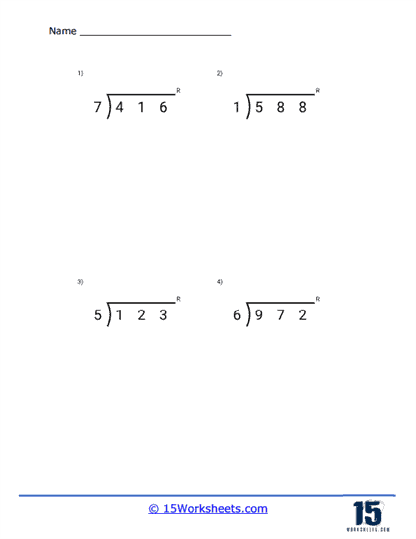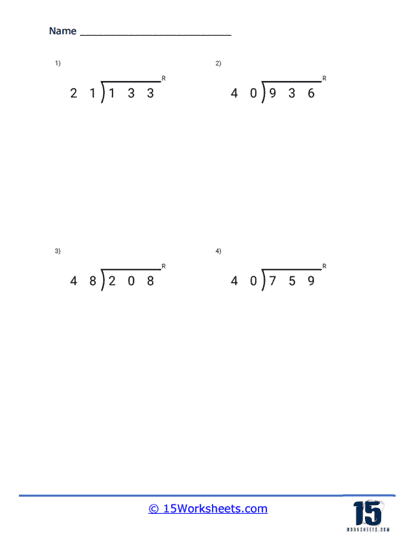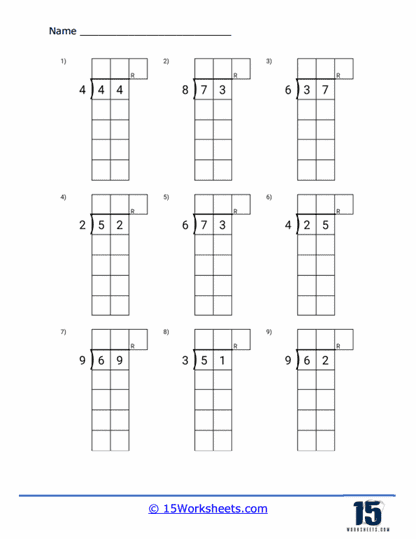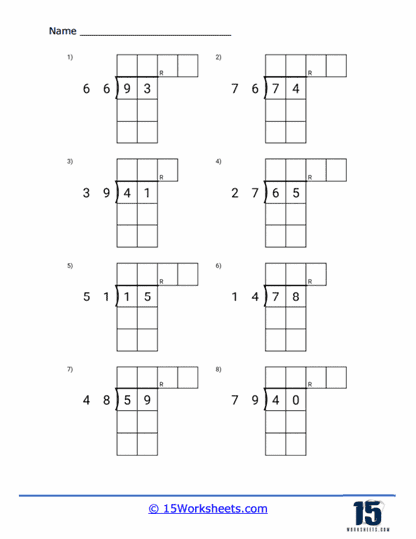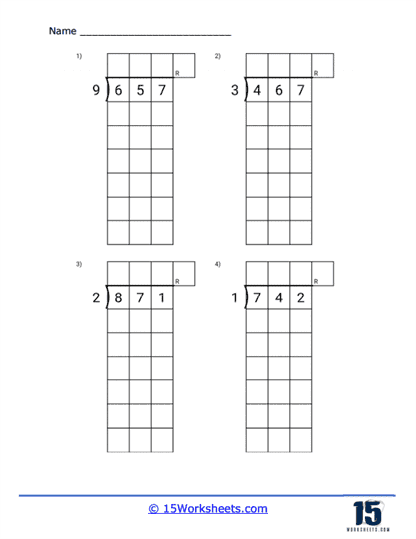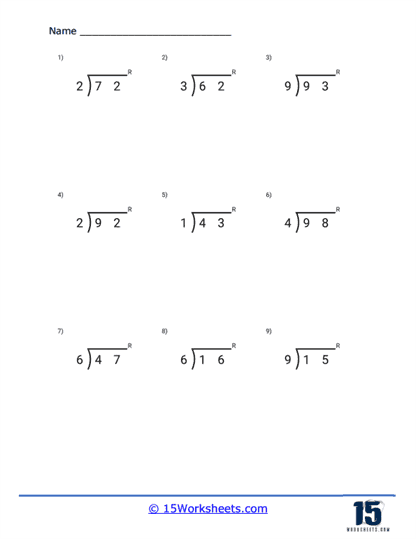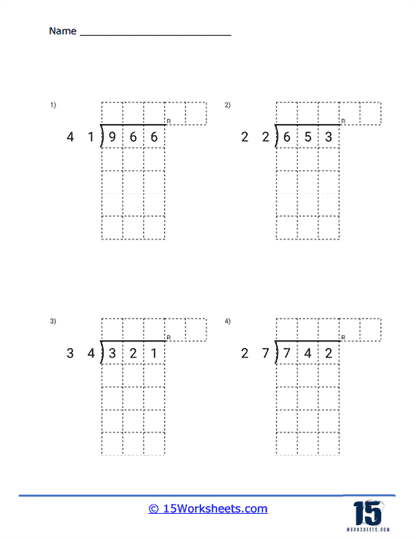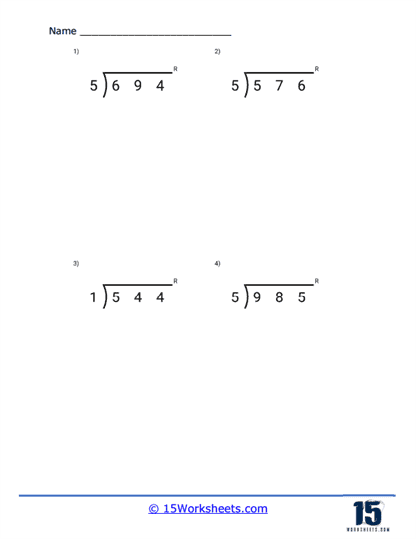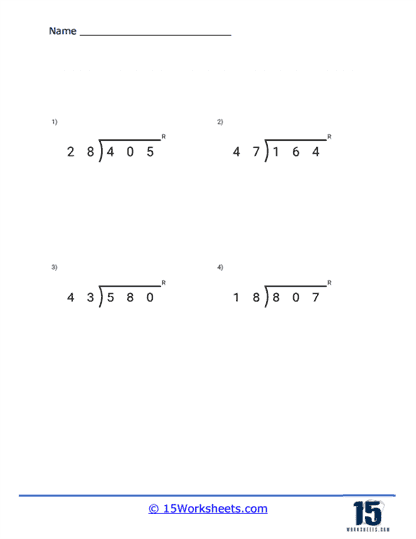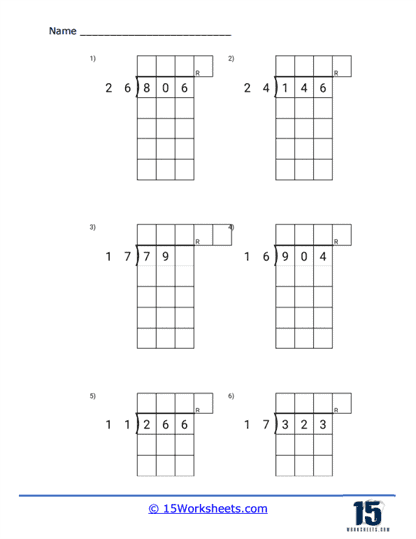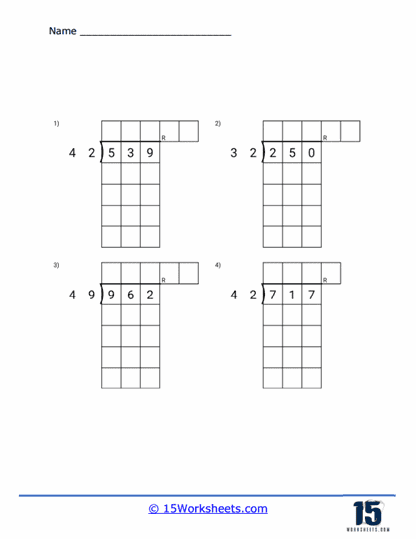Long Division Worksheets
All About These 15 Worksheets
These Long Division worksheets are designed to help students master the concept of long division. Long division is a fundamental skill in mathematics and is often a challenging concept for students to understand. These worksheets provide a variety of engaging and creative exercises to help students build their skills and confidence in using it for math problems.
Each worksheet in the series includes a mix of problems with varying degrees of difficulty, designed to challenge and engage students at different skill levels. The problems require students to divide large numbers by one- or two-digit divisors, with and without remainders.
These worksheets also provide ample space for students to show their work and write down their answers. This helps them develop their problem-solving skills and allows for feedback from their teachers or peers.
This series is most suitable for students in grades 4 to 7. It can be used in the classroom as a supplement to the math curriculum or at home as a way for parents to help their children practice and reinforce their math skills.
Overall, these Long Division worksheets provide a comprehensive and engaging way for students to develop their skills and confidence in long division. With these worksheets, students can build a solid foundation in math and develop the skills they need to succeed in higher-level math courses.
What is Long Division?
Long division is a standard method of dividing multi-digit numbers by hand. It involves breaking down the division process into a series of smaller steps that make it easier to perform and understand. Long division is particularly useful when dividing larger numbers or when working with numbers that don’t divide evenly.
The process involves repeatedly dividing the dividend (the number being divided) by the divisor (the number you’re dividing by), keeping track of the quotient (the result) and the remainder (the part left over when the division is complete). Long division is typically taught in elementary and middle school mathematics.
Here is a general outline of the long division process:
- Write the dividend and divisor in the long division format: divisor | dividend.
- Start by determining how many times the divisor can go into the first digit or the first few digits of the dividend.
- Write the result, called the partial quotient, above the dividend.
- Multiply the divisor by the partial quotient, and write the result below the dividend, aligned with the digits you were considering.
- Subtract the result from the dividend, and write the difference below the subtraction line.
- Bring down the next digit of the dividend and append it to the difference from the previous step.
- Repeat steps 2-6 until all the digits of the dividend have been used or the desired level of accuracy is achieved.
- The final result is the quotient, which may include a remainder if the division is not exact. The remainder can be expressed as “remainder x” or as a fraction by writing it over the divisor.
Long division is a useful skill for performing division without a calculator, and it helps build a strong foundation for understanding more advanced mathematical concepts.
How to Teach Long Division
Teaching long division can be challenging, as it requires students to understand and apply a sequence of steps. Here are some tips and strategies for teaching long division effectively:
- Start With the Basics – Ensure that your students have a strong foundation in basic arithmetic operations, especially multiplication and subtraction. They should also be familiar with the concepts of dividend, divisor, quotient, and remainder.
- Break Down the Process – Explain each step of the long division process in detail, and provide examples to illustrate each step. You can use the following outline to guide your explanation:
a. Setting up the problem
b. Dividing the dividend by the divisor
c. Multiplying the divisor by the quotient
d. Subtracting the result from the dividend
e. Bringing down the next digit
f. Repeating the process until the division is complete
- Use Visual Aids – Draw a long division problem on the board or use manipulatives to help students visualize the process. This can help students better understand the sequence of steps and how the numbers relate to each other.
- Teach Estimation and Mental Math – Encourage students to estimate the quotient before performing the division. This can help them develop a sense of the relative size of numbers and improve their ability to check their work.
- Model the Process – Work through several example problems step-by-step, explaining your thought process as you go. This can help students see how the steps are connected and give them a better understanding of the overall process.
- Practice, Practice, Practice – Provide plenty of practice problems for students to work on independently or in groups. Encourage students to check their work by multiplying the quotient and the divisor and adding the remainder (if any) to ensure it equals the original dividend.
- Encourage Collaboration – Have students work together to solve long division problems. This can help them learn from each other’s mistakes and develop a deeper understanding of the process.
- Be Patient and Supportive – Long division can be difficult for many students, so it’s important to be patient and offer support and encouragement as they work through the process. Provide guidance when needed, and celebrate their successes as they master the skill.
- Review and Reinforce – Regularly review the steps of long division and provide opportunities for students to practice and apply their skills. This will help them become more comfortable and confident with the process over time. Incorporate real-life examples of division problems into your lessons to make the concept more relevant and engaging.



